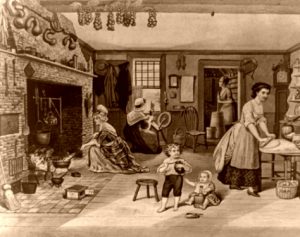 Christmas in the colonies was, for the most part, just another day. In New England, a great devoutness meant Christmas was just another day to do the Lord’s work, which means an ordinary working day. Many colonial religions banned celebrations of the holiday, claiming that it was tied to pagan traditions. Puritans abhorred the excesses of church celebrations. They passed a law in Massachusetts that punished anyone who observed the holiday with a five-shilling fine. The Quakers treated Christmas Day as any other day of the year. The Presbyterians did not have formal Christmas Day services until they noticed that their members were heading to the English church to observe the Christmas services. This sparked the Presbyterian Church to start services of their own.
Christmas in the colonies was, for the most part, just another day. In New England, a great devoutness meant Christmas was just another day to do the Lord’s work, which means an ordinary working day. Many colonial religions banned celebrations of the holiday, claiming that it was tied to pagan traditions. Puritans abhorred the excesses of church celebrations. They passed a law in Massachusetts that punished anyone who observed the holiday with a five-shilling fine. The Quakers treated Christmas Day as any other day of the year. The Presbyterians did not have formal Christmas Day services until they noticed that their members were heading to the English church to observe the Christmas services. This sparked the Presbyterian Church to start services of their own.
It was the Anglicans, Roman Catholics, and Lutherans who introduced Christmas celebrations to colonial America, but they were still much different that today’s festivities. December 25th actually began a season of festivities that lasted until January 6– the “Twelve days of Christmas.” January 6 was called Twelfth Day, and colonists found it was the perfect occasion for balls, parties, and other festivals.
Colonial Christmas was a holiday for adults, not a magical day for children. Christmas celebrations originated in the southern colonies, and activities included parties, hunts, feasts, and church services, all of which were adult activities. We do get some of our traditions from colonial days. For instance, the main decorations were holly, laurel, and garland, because these were the only plants that looked good during the middle of winter. Mistletoe was hung prominently, and couples would find their way under it at the Christmas balls.
The plantation mansions festively donned their decorations, and large feasts were prepared. The foodstuffs of colonial Christmas celebrations were similar to today’s Christmas dinner. A ham, roast, or turkey was usually the main course, followed, of course, by pie and other dessert treats. The wealth of the family determined the extent of feasting. Christmas trees were not a part of the colonial Christmas celebrations, for they did not make it to the states until the middle 1800s. Christmas carols were sung during the season and were religious in nature. “Joy to the World” gained popularity in Virginia, as noted in many journals and historical records of the time.
The tradition of gift giving did show up in colonial America, with an interesting twist. People gave gifts to their dependents, whether it be to servants, apprentices, or children. People did not return the gift giving to their superiors. And the gift giving was not the elaborate ordeal that it is today. Each recipient would most likely receive one special treasure. And the gifts were more treasured than they are today.
As more and more immigrants migrated to the New World, the Christmas holiday became more wide spread and incorporated traditions from around the word. It is accepted among some historians that Hessian soldiers who fought alongside the British first introduced the Christmas tree to the colonies during the Revolutionary War. Others claim German immigrants who settled in Eastern Pennsylvania started the tradition. All agree that prior to the Revolutionary War, Christmas was not celebrated with much merriment and outward adornment, as this did not befit the proper Puritan of that day.
Early in the 19th Century these ethnic Christmas ideas began to slip into the mainstream, earlier here than in England. Most historians trace English Christmas tree traditions to Queen Victoria and Prince Albert, who married on February 11, 1840. Albert was the son of the the Duke of Saxe-Coburg and Gotha, German states with the Christmas tree tradition, and Victoria and Albert shared a Christmas tree in the royal palace—which made the custom popular with the English population. The tradition of Christmas cards came from London.
Santa Claus himself is a combination of Saint Nicholas and Father Christmas from Dutch and English traditions. Local merchant and leader of a local historical society by the name of John Pintard objected to the roughness of Christmas as it was celebrated in the early 19th century and proposed a solution. Drawing on New York City’s Dutch origins, he promoted Saint Nicholas as the city’s patron saint – having a pamphlet printed in 1810 that’s the earliest known American image of Santa. Pintard suggested that the celebrations should be private and family-oriented rather than public and brawling.
His brother-in-law, Washington Irving, picked up on St. Nick in his book “Knickerbocker’s History“, describing a recognizably Dutch figure in a broad hat, smoking a long pipe.
Irving’s book is more popular today than it was then – probably because it wasn’t a serious work. In fact, it was satire. But Irving’s book likely did catch the eye of Clement Moore, whose own spin on Santa Claus through his oft-repeated poem, A Visit from St. Nicholas (or, as it is better known, ‘Twas the Night Before Christmas), became the first traditional art of Christmas replayed season after season in America.
from Early American Life online (http://www.ealonline.com/christmas/history/main.php) and My Merry Christmas (https://mymerrychristmas.com)
